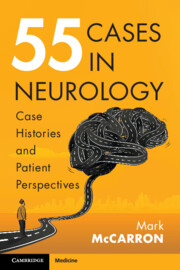Book contents
- 55 Cases in Neurology
- 55 Cases in Neurology
- Copyright page
- Contents
- Preface
- Acknowledgements
- Section 1 Visual Disturbance
- Section 2 Headache and Pain
- Section 3 Weakness
- Section 4 Behavioural and Language Changes
- Section 5 Confusion
- Case 34 Clouding of Consciousness in Hospital
- Case 35 Leaky Effects of Rising Pressure
- Case 36 Smoking Encephalopathy
- Case 37 Losing Running Memories
- Section 6 Movement Disturbances
- Section 7 Acute Onset of Neurological Symptoms
- Index
- Plate Section (PDF Only)
- References
Case 37 - Losing Running Memories
from Section 5 - Confusion
Published online by Cambridge University Press: 27 July 2023
- 55 Cases in Neurology
- 55 Cases in Neurology
- Copyright page
- Contents
- Preface
- Acknowledgements
- Section 1 Visual Disturbance
- Section 2 Headache and Pain
- Section 3 Weakness
- Section 4 Behavioural and Language Changes
- Section 5 Confusion
- Case 34 Clouding of Consciousness in Hospital
- Case 35 Leaky Effects of Rising Pressure
- Case 36 Smoking Encephalopathy
- Case 37 Losing Running Memories
- Section 6 Movement Disturbances
- Section 7 Acute Onset of Neurological Symptoms
- Index
- Plate Section (PDF Only)
- References
Summary
A 20-year-old female engineering university student presented with a three-year history of ‘déjà vu’ events and impaired awareness episodes. The déjà vu phenomena were ‘like dreams about which I cannot remember what happened’. She ran daily and estimated that about half of all her events occurred while running. At the onset of an event, she would often pause her watch and then not recall that she had paused her watch when she started running again. On one occasion, a more prolonged episode occurred. She had been running when she was next found sitting on a road as cars drove around her. Sometimes she could have multiple events in the one day. In a diary, she recorded multiple amnesic periods. At her part-time work, she could forget what she was doing or what she was supposed to be doing. Sometimes the déjà vu phenomenon would occur prior to the amnestic episodes but not always.
- Type
- Chapter
- Information
- 55 Cases in NeurologyCase Histories and Patient Perspectives, pp. 255 - 262Publisher: Cambridge University PressPrint publication year: 2023



